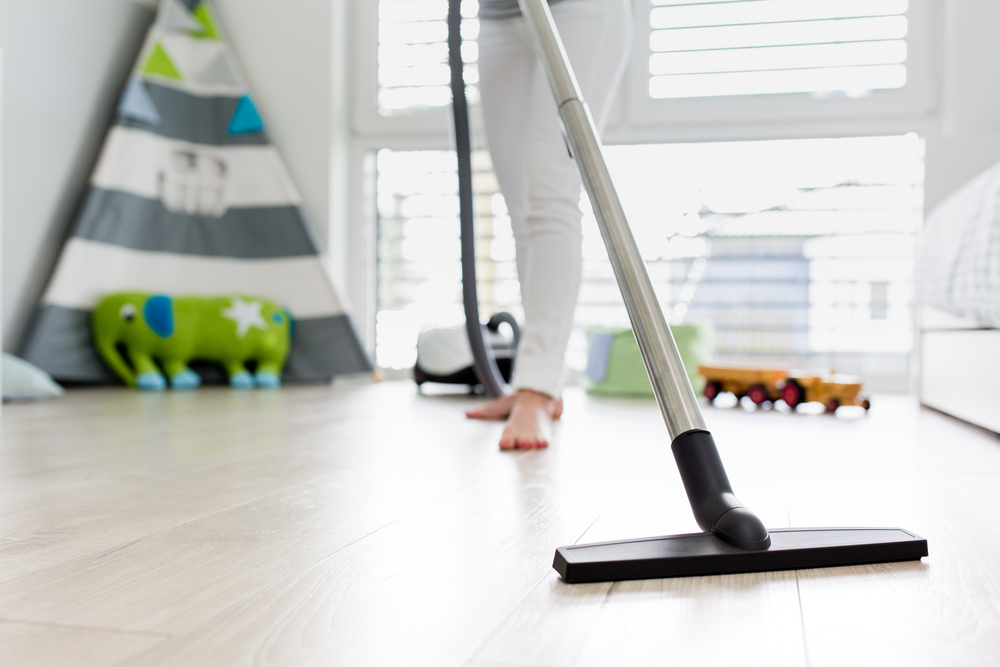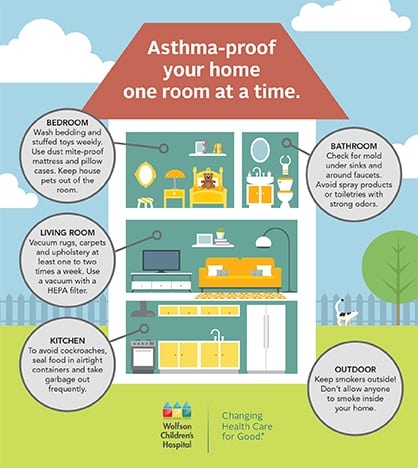
Asthma is a chronic disease that causes the airways to become irritated and inflamed. Symptoms include coughing, wheezing, difficulty breathing and chest pain. It can be intermittent, or it can interfere with daily life.
Asthma is the no. 1 reason children miss school. In some cases, it can even lead to a life-threatening attack.
Wolfson Children’s Hospital is one of four Asthma-Friendly Hospitals in the state designated by the Florida Asthma Coalition. The Asthma-Friendly Hospital designation is awarded to hospitals that excel in asthma management, reducing health risks for asthma patients and preventing asthma-related ER visits and hospitalizations.
Kerry Hogan, BSN, RN, asthma educator with THE PLAYERS Center for Child Health at Wolfson Children’s Hospital, teaches families of hospitalized patients with asthma that proper management of the condition starts at home. Taking a few precautions in each room of the house can drastically reduce the number of possible triggers for kids.
Living Room
The main culprit for triggering asthma in the living area is fabric: rugs, carpet and cloth-covered furniture all have fibers that trap irritants such as dust mites. These microscopic insects feed on dead human skin, both of which work their ways into furniture and fabrics around the house. That’s where these bugs usually take up residence. The mites’ waste and body parts are allergens for many people.
“Carpet holds onto dust mites, pet dander and other irritants. The best thing parents can do in a home with carpet is to vacuum at least one to two times a week,” said Hogan. She added that vacuuming stirs up irritants, so during cleanup, have children with asthma play outside, visit a friend’s house or at least stay out of the recently vacuumed room for a few hours.
“Purchasing a vacuum with a HEPA filter will also help capture more of those irritants out of the air,” she said.
Kitchen
Proper food storage is important for many reasons, but if a child with asthma lives in the home, it takes on a whole new importance. Cockroaches are attracted to trash cans and improperly stored food.
“When cockroaches poop, their feces become a white powdery substance and it can irritate the airways,” said Hogan. “Take your garbage out frequently and don’t leave open food on the counter. Make sure snacks are stored in an airtight container. We just want to decrease what could be attracting them as much as possible.”
If roaches do creep in, she recommends avoiding aerosol bug sprays to kill pests indoors, and sticking to gel repellants or poison baits instead.
Foods high in sulfites are known to trigger asthma flare-ups as well. Examples include dried fruit, processed potatoes and shrimp. Hogan suggests becoming familiar with sulfite-laden snacks and not purchasing them for home.
Bathroom
Mold isn’t good for anyone, but it can be especially dangerous for those with asthma. The Community Asthma Partnership at Wolfson Children’s Hospital recommends fixing leaky pipes immediately, and cleaning moldy surfaces with a bleach-based product.
“Black or green mold can be a problem,” said Hogan. “We ask parents to check under sinks and around the faucets. If there is a mold problem, have the child leave before cleaning so airborne spores don’t cause a flare-up. Many of our families rent and they can’t treat it alone, so if that is the case contact your landlord immediately.”
When using scented hair products, toiletries or perfumes, avoid strong odors and sprays. The pungent smells can irritate a child’s asthma even hours after use. Be especially careful if the child is in the room during usage.
“Strong scents can irritate the airways because of the chemicals in them. We remind people not to use those, or things like Febreze and plug-ins, especially when children are in the room,” added Hogan.
Bedroom
A child’s bedroom is where they spend anywhere from eight to 13 hours a day, and that’s only while sleeping. It may be even more if they spend time here playing or doing homework. Because of this, their bedroom may be one of the most important rooms to make asthma-friendly.
A good place to start is with a laundry routine. “We recommend washing all of the bedding about once a week in hot water. Stuffed animals are a big issue for kids, so try to limit them to one or two in the bedroom. You can wash your stuffed animals just the same as your bedding, so toss them in, too,” said Hogan.
As for the pillows and mattress, dust mite-proof cases help will keep these tiny creatures from moving in and causing irritation during the night.
And when it comes to pets, keep Fido and Fluffy out of the bedroom.
“A dog, cat or any animal with a lot of dander is going to make asthma worse. We understand that most families don’t want their pets living outside, but at least keep them out of the child’s bedroom since they’re sleeping in there for extended periods,” said Hogan.
Outside Only
When it comes to asthma triggers, there is one thing Hogan says should never be allowed into the house.
“Smoke is our biggest concern for children with asthma — it’s the no. 1 trigger,” said Hogan. “Don’t allow anyone to smoke inside your home because carpet and furniture fabric can hold the nicotine molecules inside. When someone comes back in from smoking outside, have them change their shirt or jacket so it’s not clinging to their clothing. That’s how a lot of our patients end up having their attacks.”
For more information about managing asthma, visit wolfsonchildrens.com/asthma.


















Nice post!
Thank you Phillip! We hope you found this information helpful.
Great article!
You’re spot on with the analysis of how dirty carpets and furniture get. They pretty much act just like filters and trap in allergens and bacteria (https://www.mschemdry.com/home-health-study/). It’s important to clean your carpets and your couches regularly, something that’s easy to overlook.
Thank you Ronda! We’re glad you agree. Carpets and fabric furniture can be some of the worst allergen traps, so for parents of children with asthma, it’s important to keep them as clean as possible!
I never knew that the main culprit for triggering asthma in the living area is fabric. My son just went to an asthma doctor. Thanks for the tips on making home safer for kids with asthma.
Thank you for reading, Sutton! We hope your son is feeling better after seeing an asthma specialist. If you are ever looking for more tips or resources related to asthma, please visit wolfsonchildrens.com/asthma. We offer free workshops, educational videos and printable tools for parents and kiddos alike, and it’s all available there.
I loved your post. Dust and smoke both can trigger asthma so try to maintain a clean house. Dusty floor and carpets can both cause sneezing and trigger asthma so make sure that every corner of the house is dust free. To make cleaning easy the use of compact vacuum cleaner is a smart choice.
Dust and smoke both can trigger asthma so try to maintain a clean house. Dusty floor and carpets can both cause sneezing and trigger asthma so make sure that every corner of the house is dust free. To make cleaning easy the use of compact vacuum cleaner is a smart choice.